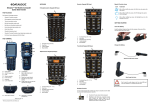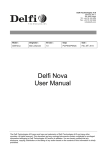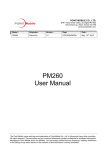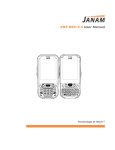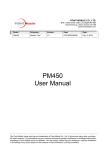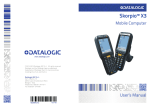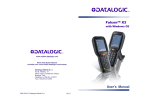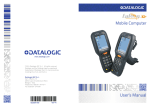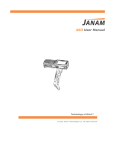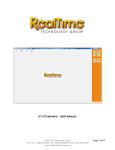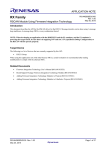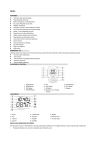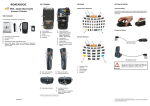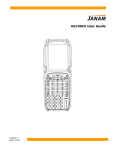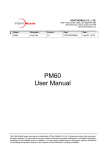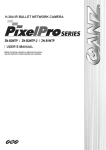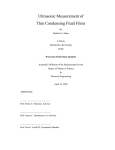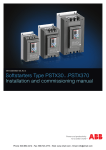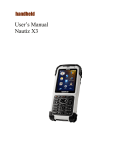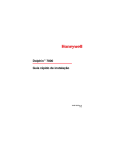Download NAUTIZ X4 Manual
Transcript
NAUTIZ X4 MANUAL . NAUTIZ X4 Manual Version 1.1 Trademarks ························································································································ 4 About the NAUTIZ X4 Handy Terminal ····················································································· 4 Accessories ······················································································································· 5 1 2.1. 2.2. 2.3. 2.4. 2.5. 2.6. 2.7. 2.8. 2.9. 2.10. 2.11. General Safety Rules ····························································································· 6 Power Supply ······································································································· 6 Laser Safety········································································································· 7 LED Safety ·········································································································· 8 FCC RF Exposure ································································································· 8 CB Scheme ········································································································· 8 FCC Part 15 Regulation ·························································································· 8 Canadian Compliance ···························································································· 9 Radio Compliance ······························································································· 10 WEEE Compliance ······························································································ 10 China Compliance ······························································································· 10 3.1. 3.2. 3.3. 3.4. 3.5. 3.6. 3.7. 3.8. 3.9. 3.10. 3.11. Install the Battery ································································································ Charge the Batteries ···························································································· LED Indicators ···································································································· Guidelines for Battery Pack Use and Disposal ··························································· Turn Your Device On ··························································································· Desktop ············································································································ Indicator Icons ···································································································· Using the Stylus ·································································································· Selecting Program ······························································································· Pop-Up Menus ··································································································· Using Windows Explorer ······················································································· 11 12 13 13 15 15 16 17 17 17 17 4.1. 4.2. 4.3. 4.4. 4.5. 4.6. 4.7. 4.8. 4.9. 4.10. 4.11. 4.12. 4.13. 4.14. 4.15. 4.16. 4.17. 4.18. 4.19. 4.20. 4.21. 4.22. Feature of Your Device ························································································· NAUTIZ X4 Handy Terminal ·················································································· Front Panel Layout ······························································································ Display Backlight ································································································· Keypad Backlight ································································································ Using Screen Protectors ······················································································· Installing Your Screen Protector ············································································· Back Panel Layout ······························································································ Left Side Panel Layout ························································································· Installing Memory Cards ······················································································· Right Side Panel Layout ······················································································· Top Panel Layout ································································································ Bottom Panel Layout ···························································································· Peripherals and Accessories·················································································· USB ActiveSync Cable ························································································· Li-ion Battery Packs ····························································································· Battery Power····································································································· Main Battery Pack ······························································································· Managing Main Battery Power ··············································································· Resetting the Terminal ························································································· Suspend Mode ··································································································· Memory Allocation ······························································································· 18 18 19 20 20 21 21 25 25 25 26 26 27 28 28 28 28 28 30 30 31 32 handheld NAUTIZ X4 Manual Version 1.1 2 4.23. 4.24. Care and Cleaning of the Products ·········································································· 32 NAUTIZ X4 Technical Specifications ······································································· 33 5.1. 5.2. 5.3. 5.4. 5.5. 5.6. Numeric Keypad Layout ······················································································· Navigation Keys ·································································································· Basic Keys········································································································· Alpha/Numeric Modes ·························································································· Alpha Indicators on the Numeric Keys ····································································· Program Buttons ································································································· 35 35 35 36 36 37 6.1. 6.2. 6.3. 6.4. 6.5. 6.6. 6.7. 6.8. 6.9. 6.10. 6.11. Overview ··········································································································· Available Image Engines ······················································································ Depth of Field ····································································································· Supported Bar Code Symbologies ·········································································· Activating the Engine ··························································································· Using Demos ····································································································· Decoding ··········································································································· To Decode a Bar Code ························································································· Sample Bar Codes ······························································································ Omni-Directional Scanning Positions ······································································· Capturing Images (IT5300SR Engine Only) ······························································ 38 39 40 41 41 42 42 42 42 43 43 7.1. 7.2. 7.3. 7.4. 7.5. 7.6. 7.7. 7.8. 7.9. Overview ··········································································································· Available Laser Engines ······················································································· Depth of Field ····································································································· Supported Bar Code Symbologies ·········································································· Activating the Engine ··························································································· Using Demos ····································································································· Decoding a Bar Code ··························································································· Sample Bar Code ································································································ Scanning Positions ······························································································ 44 44 44 45 45 45 45 46 46 8.1. 8.2. Overview ··········································································································· 47 Enabling ScanWedge ··························································································· 47 9.1. 9.2. 9.3. 9.4. 9.5. System Properties ······························································································· Power properties ································································································· Program Buttons properties ··················································································· Backlight Properties ····························································································· Scanner Settings ································································································· 49 50 51 52 53 10.1. 10.2. 10.3. 10.4. 10.5. 10.6. Communication Options ······················································································· Installing Additional Software ················································································· Connecting the USB ActiveSync Cable ···································································· ActiveSync Communication ··················································································· Communication Type ··························································································· Hardware Requirements for Setup ·········································································· 57 57 58 58 58 58 handheld NAUTIZ X4 Manual Version 1.1 3 10.7. 10.8. 10.9. 10.10. 10.11. 10.12. 10.13. 10.14. 10.15. 10.16. Software Requirements for Communication ······························································ Setting Up the Host Workstation ············································································· Communicating with the Handy Terminal ·································································· Synchronizing with the Host Workstation ·································································· Exploring the Terminal from the Workstation ····························································· Adding Programs via ActiveSync ············································································ Wireless Radios ·································································································· Connecting the Terminal to a Wireless Network ························································· WLAN (802.11b/g/n Radio) ··················································································· Adding Programs from the Internet ·········································································· 11.1. 11.2. 11.3. Enabling the WLAN Radio ····················································································· 63 Establishing a Connection ····················································································· 63 Using the Scan feature ························································································· 64 12.1. 12.2. 12.3. 12.4. Enabling the Bluetooth Radio ················································································· Connecting to Other Devices ················································································· Pairing Bluetooth Devices ····················································································· Setting Up a Bluetooth Printer ················································································ 65 66 66 66 13.1. 13.2. 13.3. 13.4. 13.5. 13.6. 13.7. 13.8. Overview ··········································································································· Battery Charging ································································································· Power Supply ····································································································· Front Panel ········································································································ Back Panel ········································································································ Powering the Single Slot Docking Cradle or Single Slot Ethernet Cradle Device················ Charging the Battery ···························································································· Technical Specifications ······················································································· 66 67 67 67 68 69 70 70 handheld 59 59 59 59 59 60 61 61 62 62 NAUTIZ X4 Manual Version 1.1 1. INTRODUCTION Thank you for purchasing NAUTIZ X4 handy terminal. This manual generally provides you with the safety information and basic features and operations of the NAUTIZ X4 device. Please read all safety precautions and this manual carefully before using your handy terminals and peripherals to ensure safe and proper use. Trademarks The official name of Windows XP is Microsoft Windows XP Operating System. The official name of Windows Vista is Microsoft Windows Vista Operating System. The official name of Windows 7 is Microsoft Windows 7 Operating System. Microsoft, Windows, Windows Embedded Handheld 6.5 Pro, ActiveSync, and the brand names and product names of other Microsoft products are trademarks of Microsoft Corporation in the US and other countries. Other company and product names given in this manual or displayed in this software may be the trademarks of their respective companies. About the NAUTIZ X4 Handy Terminal The new NAUTIZ X4 is the latest generation handy terminal device, combining a pocket sized rugged form factor built on Microsoft Windows Embedded Handheld 6.5 Pro operating system. The NAUTIZ X4 is designed for retail warehousing and logistics applications where maximum performance and durability is required in compact handheld device. The NAUTIZ X4 handy terminal is available in different models depending on the options. 4 XXX - XX X X - X - X NX4 - 1D-N4313 G-GSM N-Numeric - R-RFID - E-English - 2D-N5603 C-CDMA Q-Qwerty - 0-not install - G-German - - - F-French - - - I-Italian - - - S-Spanish handheld NAUTIZ X4 Manual Version 1.1 Accessories P/N Description NX4-1004 NX4-1007 Standard battery NX4-1008 NX4-1015 NX4-1010 NX4-1005 NX4-1023 NX4-1024 NX4-1011 Ethernet base (Single Ethernet Cradle) Quad Battery Charger Micro-usb cable AC adapter Handstrap Wrist Lanyard Stylus and tether Homebase office docking station (Single Slot Cradle) Cradles (including DC 5V 4A Adaptor) Single Slot Cradle Single Ethernet Cradle Batteries 4000mAh Battery Pack, Standard Capacity Power Supply AC Adaptor, INPUT: AC100~240V 50/60Hz, OUTPUT: DC5V 1.8A with MicroUSB type MicroUSB ActiveSync Cable Others Stylus Pen and tether Wrist Lanyard Handstrap NAUTIZ X4 handy terminal contains the following items basically: • • • • • • • • • ☞ ☞ 5 Handy terminal MicroUSB ActiveSync Cable 5V/1.8A AC Adaptor with MicroUSB type AC Plugs Battery Pack Stylus Pen and tether Wirst Lanyard Handstrap LCD Screen Protection Film Keep the original packaging for use when sending products to the technical assistance center. Damage caused by improper packaging is not covered under the warranty Rechargeable battery packs are not initially charged or discharged. Before you begin to use, you must charge the battery packs first. See Paragraph 3.2. handheld NAUTIZ X4 Manual Version 1.1 2. SAFETY REGULATIONS Symbols in this manual In this manual, some important items are described with the symbols shown below. Be sure to read these items before using this equipment. Indicates a potentially hazardous situation which, if not avoided, could result in death serious injury, or serious damage, or fire in the equipment or surrounding objects. ☞ Indicates a potentially hazardous situation which, if not avoided, may result in minor or moderate injury, partial damage to the equipment or surrounding objects, or loss of data. Indicates information to which you should pay attention when operating the equipment This section outlines the safety precautions associated with using NAUTIZ X4 handy terminal. ☞ NAUTIZ X4 handy terminals meet or exceed the requirements of all applicable standards organizations for safe operation. However, as with any electrical equipment, the best way to ensure safe operation is to read this manual carefully before performing any type of connection to the handy terminal and operate them according to the agency guidelines described in the manual. 2.1. General Safety Rules CAUTION 2.2. Power Supply The power supply for this device has met applicable KCC/CCC safety requirements. Please adhere to the following safety instructions per UL guidelines: • FAILURE TO FOLLOW THE INSTRUCTIONS OUTLINED MAY LEAD TO SERIOUS PERSONAL INJURY AND POSSIBLE PROPERTY DAMAGE. • IMPORTANT SAFETY INSTRUCTIONS – SAVE THESE INSTRUCTIONS. DANGER – TO REDUCE THE RISK OF FIRE OR ELECTRIC SHOCK, CAREFULLY FOLLOW THESE INSTRUCTIONS. Use only Handheld-approved power supply. Use of a non-Handheld-approved power supply may be dangerous and the warranty does not cover damage to the device caused by non-Handheld-approved power supply. The package includes international AC plugs. The AC plugs must be plugged in the power supply before the power supply itself is plugged on the wall outlet. The power supply is intended to be correctly oriented in a vertical or horizontal or floor mount position. 6 handheld NAUTIZ X4 Manual Version 1.1 2.3. Laser Safety CAUTION A Class 2 laser is safe because the blink reflex limit the exposure to no more than 0.25 seconds. It only applies to visible-light lasers (400–700 nm). Class-2 lasers are limited to 1mW continuous wave, or more if the emission time is less than 0.25 seconds or if the light is not spatially coherent. Although staring directly at the laser beam momentarily causes no known biological damage, avoid staring at the beam as one would with any very strong light source, such as the sun. Avoid that the laser beam hits the eye of an observer, even though reflective surfaces such as mirrors, etc. The laser light is visible to the human eye and is emitted from the window indicated in the figure. Laser output window (Model label) If the above laser light label is attached to your device, it indicates the product contains a laser engine or laser aimer that emits the laser light. The following information is provided to comply with the rules imposed by international authorities and refers to the correct use of NAUTIZ X4 handy terminal. 7 handheld NAUTIZ X4 Manual Version 1.1 Laser Safety Statement This product has been tested in accordance with and complies with CDRH 21 CFR 1040.10 and 1040.11 and IEC 60825-1 Ed 2 (2007) except for deviations pursuant to Laser Notice No 50, dated June 24, 2007. LASER LIGHT. DO NOT STARE INTO BEAM. CLASS 2 LASER PRODUCTS. 1 mW MAX OUTPUT: 650nm. For installation, use and maintenance, it is not necessary to open the device. WARNING: Do not attempt to open or otherwise service any components in the optics cavity. Opening or servicing any part of the optics cavity by unauthorized personnel may violate laser safety regulations. The optics system is a factory only repair item. WARNING: Use of controls or adjustments or performance of procedures other than those specified herein may result in exposure to hazardous visible laser light. WARNING: Use of optical systems with the scanner will increase eye hazard. Optical instruments include binoculars, microscopes, eye glasses and magnifying glasses. 2.4. LED Safety The LED output on this device has met IEC62471 LED safety and certified to be under the limits of a CLASS 1 LED product. 2.5. FCC RF Exposure This device complies with FCC RF exposure guidelines set forth for an uncontrolled environment. 2.6. CB Scheme This device complies with CB Scheme IEC 60950-1 2.7. FCC Part 15 Regulation Pursuant to part 15 of the FCC Rules, you are cautioned that changes or modifications not expressly approved by Handheld could void your authority to operate the NAUTIZ X4 handy terminal. This device complies with part 15 of the FCC Rules. Operation is subject to the following two conditions: (1) This device may not cause harmful interference, and (2) this device must accept any interference received, including interference that may cause undesired operation. This device has been tested and found to comply with the limits for a Class B digital device, pursuant to Part 15 of the FCC Rules. These limits are designed to provide reasonable protection against harmful interference in a residential installation. This equipment generates uses and can radiate radio frequency energy and, if not installed and used in accordance with the instructions, may cause harmful interference to radio communications. However, there is no guarantee that interference will not occur in a particular installation. If this equipment does cause harmful interference to radio or television reception, which can be determined by turning the equipment off and on, the user is encouraged to try to correct the interference by one or more of the following measures: 8 • Reorient or relocate the receiving antenna. • Increase the separation between the equipment and receiver. • Connect the equipment into an outlet on a circuit different from that to which the receiver is connected. • Consult the dealer or an experienced radio/TV technician for help. handheld NAUTIZ X4 Manual Version 1.1 In accordance with FCC 15.21, changes or modifications not expressly approved by the party responsible for compliance could void the user‘s authority to operate the equipment. The antenna(s) must not be co-located or operating in conjunction with any other antenna or transmitter. To maintain compliance with FCC RF exposure guidelines for body-worn operation, do not use accessories that contain metallic components. 2.8. Canadian Compliance This radio transmitter has been approved by Industry Canada to operate with the antenna types listed below with the maximum permissible gain and required antenna impedance for each antenna type indicated. Antenna types not included in this list, having a gain greater than the maximum gain indicated for that type, are strictly prohibited for use with this device. Under Industry Canada regulations, this radio transmitter may only operate using an antenna of a type and maximum (or lesser) gain approved for the transmitter by Industry Canada. To reduce potential radio interference to other users, the antenna type and its gain should be so chosen that the equivalent isotropically radiated power (e.i.r.p.) is not more than that necessary for successful communication. This device complies with Industry Canada license-exempt RSS standard(s). Operation is subject to the following two conditions: (1) this device may not cause interference, and (2) this device must accept any interference, including interference that may cause undesired operation of the device. Le présent émetteur radio a été approuvé par Industrie Canada pour fonctionner avec les types d'antenne énumérés ci-dessous et ayant un gain admissible maximal et l'impédance requise pour chaque type d'antenne. Les types d'antenne non inclus dans cette liste, ou dont le gain est supérieur au gain maximal indiqué, sont strictement interdits pour l'exploitation de l'émetteur. Conformément à la réglementation d'Industrie Canada, le présent émetteur radio peut fonctionner avec une antenne d'un type et d'un gain maximal (ou inférieur) approuvé pour l'émetteur par Industrie Canada. Dans le but de réduire les risques de brouillage radioélectrique à l'intention des autres utilisateurs, il faut choisir le type d'antenne et son gain de sorte que la puissance isotrope rayonnée équivalente (p.i.r.e.) ne dépasse pas l'intensité nécessaire à l'établissement d'une communication satisfaisante. Le présent appareil est conforme aux CNR d'Industrie Canada applicables aux appareils radio exempts de licence. L'exploitation est autorisée aux deux conditions suivantes : (1) l'appareil ne doit pas produire de brouillage, et (2) l'utilisateur de l'appareil doit accepter tout brouillage radioélectrique subi, même si le brouillage est susceptible d'en compromettre le fonctionnement. 9 handheld NAUTIZ X4 Manual Version 1.1 2.9. Radio Compliance NAUTIZ X4 RF terminals are in conformity with all essential requirements of the R&TTE Directive (1999/5/EC). This device is marked with in accordance with the Class II product requirements specified in the R&TTE Directive, 1999/5/EC. The device is intended for use throughout the European Community; PAN European Frequency Range: 2.402 ~ 2.480 GHz. Restrictions for use in France are as follows: • Indoor use: maximum power (EIRP*) of 100 mW for the entire 2.400 ~ 2.4835 GHz • Outdoor use: Maximum power (EIRP*) of 100 mW for the 2.400 ~ 2.454 GHz band and maximum power (EIRP*) of 10 mW for the 2.454 ~ 2.483 GHz band. The CE mark on the device indicates that the system has been tested to and confirm with the provisions noted within the 2004/108/EC Electromagnetic Compatibility Directive and the 2006/95/EC Low Voltage Directive, 1999/5/EC (R&TTE), and 2011/65/EU (RoHS). Handheld shall not be responsible for use of our product with equipment (i.e., power supplies, personal computers, etc.) that is not CE marked and does not comply with the Low Voltage Directive. 2.10. WWAN In radio systems configured with mobile computers and access points, the frequencies to be used must be allowed by the spectrum authorities of the specific country in which the installation takes place. Be absolutely sure that the system frequencies are correctly set to be compliant with the spectrum requirements of the country. The Radio modules used in this product automatically adapt to the frequencies set by the system and do not require any parameter settings .The TYPE field shows the correspondence between NAUTIZ X4 types and radio modules: HSPA+ HSPA+, or Evolved High-Speed Packet Access, is a technical standard for wireless, broadband telecommunication. HSPA+ enhances the widely used WCDMA (UMTS) based 3G networks with higher speeds for the end user. ☞ The Commercial Mobile Alert System (CMAS), also known as Wireless Emergency Alerts (WEA), is an alerting network in the United States designed to disseminate emergency alerts to mobile devices such as cell phones and pagers. This device does not support this feature. 2.11. WEEE Compliance Information for the user in accordance with the European Commission Directive 2012/19/EU of the European Parliament and of the Council of 4 July 2012 on Waste Electrical and Electronic Equipment (WEEE) This product has required the extraction and use of natural resources for its production. It may contain hazardous substances that could impact health and the environment, if not properly disposed. In order to avoid the dissemination of those substances in our environment and diminish the pressure on the natural resources, we encourage you to reuse, recycle and recover the product. If the product is disposed according to the Directive, it will avoid potentially negative consequences to the environment and human health which otherwise could be caused by incorrect disposal. The product marked with crossed out wheeled bin must be disposed separately from municipal waste. For more detailed information about disposal, reuse, and recycle system, contact your local or regional waste administration. 10 handheld NAUTIZ X4 Manual Version 1.1 3. GETTING STARTED 3.1. Install the Battery The HANDY TERMINAL is shipped with the battery packaged separate from the unit. Follow the steps below to install the battery. 1. Remove the battery compartment door by moving the door’s locks right and lifting up the bottom of door. Recess of hanging Battery door lock 2. Insert the battery well with the battery cells facing top. 1 2 3. Replace the battery door to start from bottom to top door’s lock downwards. 2 1 11 handheld NAUTIZ X4 Manual Version 1.1 ☞ ☞ Two points of Battery guide stopper must be pertinently inserted to rear cover battery guide stopper hole The battery door must be installed prior to booting the unit. Use only Handheld-approved Li-Ion battery packs. Unauthorized battery may result in damage not covered by the warranty. 3.2. Charge the Batteries Handy Terminals ship with only main battery pack significantly charged of power. Charge the main battery pack with the Handy Terminal charging cable for a minimum of 4 or 6 hours depending on your battery before initial use. 1. Attach the appropriate plug adapter to the plug of the power cable. 2. Insert the plug into the appropriate power source. Plug the Handy Terminal power cable into the USB Jack on the side end of the unit. Use only Handheld-approved peripherals, power cables, and power adapters. Unauthorized peripherals, cables, or power adapters may cause batteries to explode or damage your device. DO NOT attempt to charge damp/wet handy terminals or batteries. All components must be dry before connecting to an external power source. Batteries must be charged at a temperature ranging from 0~45℃ (±3℃). If you don’t follow the guide, it might have a harmful effect on the battery life. ☞ 12 After the battery has been charged, disconnect the DC Power Jack from the terminal. If you stay on that plug in use, it is possible to break the power code. Rechargeable battery packs are not initially charged. Therefore the first operation to perform is to charge them. handheld NAUTIZ X4 Manual Version 1.1 ☞ : If you remove the battery pack or it completely discharges, you have 30 minute window of time to insert a charged battery pack before the battery completely discharges. 3.3. LED Indicators The red LED is ON while charging the battery and the green LED is ON when the battery is fully charged. Alternatively, it is also possible to recharge the battery pack by using the single slot cradle, the single Ethernet cradle or the 4-slot battery charger. During the charging process the LED positioned at the upper side of the display is red constant. Once the charging process has been completed this LED is green constant. If the battery pack is removed from the handy terminal, it can be recharged by inserting it into the rear slot of the single slot cradle, the single Ethernet cradle or the 4-slot battery charger. 3.4. Guidelines for Battery Pack Use and Disposal The following are general guidelines for the safe use and disposal of batteries: Store the terminal and the spare batteries between 20 to 30 ºC (68 to 86 ºF) in order to maintain optimal battery performance. Standard batteries must be charged at a temperature ranging from 0 to 45℃(±3℃). The battery level may not be displayed correctly for some minutes after the disconnection if the handy terminal is disconnected from power supply before the charging cycle is completed. The handy terminal could get warm during charging. This is normal and does not mean a malfunction. To achieve the best battery life, turn off the radios not in use. Rechargeable battery packs is not initially charged. Therefore the initial operation to perform is to charge them. See below. By default, the battery pack is disconnected at the factory to avoid damage due to excessive draining. Annual replacement of rechargeable battery pack avoids possible risks or abnormalities and ensures maximum performance. : DO NOT attempt to charge damp/wet handy terminals or batteries. All components must be dry before connecting to an external power source. Never throw a used battery in the trash. It contains heavy metals and should be recycled according to local guidelines Storage of batteries for long time at fully charged status or at fully discharged status should be avoided. Only in case of long storage, in order to avoid deep discharge of the battery, it's recommended to partially recharge the battery every two-three months to keep the charge status at a medium level. Installing, charging and/or any other action should be done by authorized personnel and following this manual. The battery pack may get hot, explode, ignite, and/or cause serious injury if exposed to abusive conditions. If the battery pack is replaced with an improper type, there is risk of explosion. Do not place the battery pack in or near a fire or heat; do not place the battery pack in direct sunlight, or use or store the battery pack inside unventilated areas in hot weather; do not place the battery pack in microwave ovens, dryer, high pressure containers, on induction cookware or similar device. Doing so may cause the battery pack to generate heat, explode or ignite. Using the battery pack in this manner may also result in a loss of performance and a shortened life expectancy. Use only a Handheld approved power supply. The use of an alternative power supply will void the product warranty, may cause product damage and may cause heat, explode or ignite. The area in which the units are charged should be clear of debris and combustible materials or chemicals. 13 handheld NAUTIZ X4 Manual Version 1.1 Do not use the battery pack in any other manner outside its intended use in Handy Terminal and peripherals. Do not short-circuit the battery pack contacts connecting the positive terminal and negative terminal. This might happen, for example, when you carry a spare battery pack in your pocket or purse; accidental short–circuiting can occur when a metallic object such as a coin, clip, or pen causes direct connection of the contacts of the battery pack (these look like metal strips on the battery pack). Short–circuiting the terminals may damage the battery pack or the connecting object. Do not apply voltages to the battery pack contacts. Do not pierce the battery pack with nails, strike it with a hammer, step on it or otherwise subject it to strong impacts or shocks. Do not disassemble or modify (i.e. bend, crush or deform) the battery pack. The battery pack contains safety and protection devices, which, if damaged, may cause the battery pack to generate heat, explode or ignite. In case of leakage of liquid from the battery, avoid contact with liquid the skin or eyes. If the contact occurs, immediately wash the affected area with water and consult a doctor. Do not solder directly onto the battery pack. Do not expose the battery pack to liquids. Avoid any knocks or excessive vibrations. If the device or the battery is dropped, especially on a hard surface, you should take it to the nearest Authorised Repair Centre for inspection before continuing to use it. Do not replace the battery pack when the device is turned on. Do not remove or damage the battery pack’s label. Do not use the battery pack if it is damaged in any part. Battery pack usage by children should be supervised. Collect and recycle waste batteries separately from the device in comply with European Directive 2006/66/EC, 2011/65/EU, 2012/19/EU and subsequent modifications, US and China regulatory and others laws and regulations about environment. ☞ In order to guarantee an adequate operating autonomy, when replacing the battery pack the handy terminal checks the battery energy level. If the battery is not sufficiently charged, handy terminal does not turn on. In this case, either substitute the battery pack with a charged one (sufficiently charged) or insert handy terminal into a powered cradle or plug it into the direct power supply. 14 handheld NAUTIZ X4 Manual Version 1.1 ☞ 3.5. Turn Your Device On 3.6. Desktop You can access the Desktop any time by tapping the Change Views icon in the command bar and selecting Desktop on the popup menu Tap the touch screen once to zoon in the upper menu 15 handheld NAUTIZ X4 Manual Version 1.1 3.7. Indicator Icons The command bar, located at the upper of application screens, provides access to many system functions and programs. Icons Meaning Open the start menu Access the Wireless Manager Open the Scanner option menu Indicates the Keypad value Shows phone signal mode Shows the volume Indicates the Battery Control Panel (CPL) Indicates Clock & Alarm CPL zoom in/ out Access the Bluetooth radio Left and right arrows are used to scroll through additional icons Icon Meaning Indicates AC connection mode Indicates WAN (Phone) connection mode Indicates Sound connection mode Indicates LAN / Bluetooth mode Indicates Keypad mode 16 handheld NAUTIZ X4 Manual Version 1.1 3.8. Using the Stylus The terminal comes with a stylus included in a loop on the Lanyard. Use this stylus (or your finger) to select or enter information on the touch screen. The stylus functions as a mouse; generally, a tap is the same as a click. Tap Tap the touch screen once to open menu items and select options. Drag Hold the stylus on the screen and drag across the screen to select text and images. Tap & hold Tap and hold the stylus on an item and a pop-up menu appears. On the pop-up menu, tap the action of the task you want to perform. : Use of objects, such as paper clips, pencils, or ink pens on the touch screen can damage the input panel and may cause damage not covered by the warranty. 3.9. Selecting Program Tap Start -> Programs. To open a program, tap the icon on the menu. 3.10. Pop-Up Menus You can quickly choose an action for an item using the pop-up menus. 1. Tap and hold the stylus on the item name. The pop-up menu appears. 2. Lift the stylus and tap the action you want to perform. The contents of pop-up menus change according to the program you are using. 3.11. Using Windows Explorer Use Windows Explorer to navigate through the files on your system. Start menu -> File explorer Move files by tapping and holding on the file, and then tapping Cut, Copy or Paste on the pop-up menus that appear. 17 handheld NAUTIZ X4 Manual Version 1.1 4. GET TO KNOW YOUR DEVICE 4.1. Feature of Your Device The following list outlines a few of the feature included in your device. 4.2. Operating Systems: Microsoft Windows Embedded Handheld 6.5 Pro Micro Processor: Cortex-A8 1GHz RAM Memory: 512MB FLASH Memory: 1GB 3.5” VGA Display: 480x640 Transmissive TFT Resistive Industrial Grade Touch Screen Keyboards: Numeric, Qwerty Micro SDHC Expansion Memory Card Interface: Support up to 32 GB Power Supply : MicroUSB power adaptor Interfaces : Micro-USB connector : USB 2.0 High Speed HandyLink connector: USB 2.0 High speed Client, Host (USB Host for Ethernet Cradle), Scan Engine: • 1D engine: N4313 • 2D engine: N560X Charging Battery: Li-ion battery, 3.7V/4000mAh/14.8Wh IP65 certified enclosures Audio: Integral Microphone, Earpiece, Loud, Speaker, 3.5pi 4pole Jack for Ear-Mic headset BT: Bluetooth Radio 2.1+EDR with Internal Antenna WLAN: 802.11 b/g/n Radio with Internal Antenna Notification LEDs 1) Power indications, 2) Scan reading indications & OS notifications Notification Vibration Motor Camera : 5M pixel CMOS camera with AutoFocus and LED flash Sensors : Light/Proximity sensor and Acceleration sensor 18 NAUTIZ X4 Handy Terminal P/N : NX4-1DGN-0-E/ NX4-2DGQ-R-E/ NX4-2DGQ-0-E/ NX4-2DGN-R-E/ NX4-2DGN-0-E GSM/GPRS/EDGE : Quad band, 850/900/1800/1900MHz UMTS/HSPA+: Five band, 800/850/900/1900/2100MHz P/N : NX4-1DCN-0-E CDMA : Dual Band, US 800/1900MHz GPS: Standalone and Assisted GPS handheld NAUTIZ X4 Manual Version 1.1 4.3. Front Panel Layout Light/Proximity sensor LED Receiver Touch screen display Scan key Keyboard (33-key numeric) LED Indicator Shows the information needed to operate your device as follows: Note: The LED is user-programmable. LED Color Meaning Red Lights when main battery is charging. Blinks, when the battery is very low (<10%), Lights when the battery is low (<20%), Blinks as Red/ Green by turns when it is no battery or not recognized Green Lights when the PDA resets Lights when main battery charging has completed. Blinks as Red / Green by turns when it is no battery or not recognized Blue Lights when a scan Pass Lights when PDA wakes up Lights when a scan fails Lights when PDA suspends 19 handheld NAUTIZ X4 Manual Version 1.1 Keypad 33 numeric keypad (includes side scan and volume, power button). 55 qwerty keypad (includes side scan and volume, power button). Microphone The integrated microphone can be used for audio recording and phone call. Touch Screen Display The display is a LCD (Liquid Crystal Display) with a Capacity touch screen. The 3.5” VGA (Video Graphic Array) is transmissive active matrix color and backlit. The resolution is 480 x 640; see Display Backlight on paragraph 4.4. For touch screen input, use the stylus included with the terminal or your finger. The method you choose depends on which one is most appropriate for your application. While there is a great deal of variation in different applications, you generally achieve greater accuracy with the stylus for buttons or icons that are close together. : Use of objects, such as paper clips, pencils, or ink pens on the touch screen can damage the input panel and may cause damage not covered by the warranty. 4.4. Display Backlight The intensity of the backlight of the touch screen display may be changed, and the backlight may be programmed to turn off after the terminal has been idle for a specified period of time. To adjust the intensity of the backlight while on battery power, tap Start -> Settings -> System -> Backlight. Screen Backlight - Battery/External Power Move the slider to adjust the screen backlight while on battery power. You may turn the screen backlight off if the device is not used for a designated period of time by checking the option and designating the desired time period. You may also turn on the screen backlight when a button is pressed or the screen is tapped by selecting the appropriate checkbox. 20 handheld NAUTIZ X4 Manual Version 1.1 ☞ Using the backlight option while on battery power substantially reduces battery life. You may make the same changes when on external power by tapping the External tab. 4.5. Keypad Backlight To turn on the keypad backlight, check the checkbox. The duration of backlight of keypad synchronizes with LCD backlight’s. 4.6. Using Screen Protectors Handheld defines proper use of the terminal touch panel display as using a screen protector and proper stylus. Screen protectors maintain the ongoing integrity (i.e., prevent scratching) of the touch panel, which is why their use is recommended for applications that require a high to medium level of interface with the touch panel. Handheld also mandates use of the proper stylus, which is one that has a stylus tip radius of no less than 0.8mm. Use of the stylus included with the terminal is recommended at all times. 4.7. Installing Your Screen Protector When installing a screen protector, use a flat plastic card (e.g., credit card) to apply the screen protector smoothly and remove any air bubbles. 1. Press the Power key to put the terminal in suspend mode. 2. Clean the touch panel thoroughly with a clean, non-abrasive, lint-free cloth, Make sure nothing is on the touch panel. 3. Blue tag with backing film: Peel off this mask before application. 21 handheld NAUTIZ X4 Manual Version 1.1 4. ☞ Align the exposed edge of the screen protector along the left edge of the touch panel. Make sure that it lies flush with edges of the touch panel. To reposition the screen protector, lift up gently and reapply. 5. Yellow tag with cover film: “Please peel off this mask after application completed. 6. Press gently but firmly. Use the card a necessary to smooth out any air pockets or bumps after allocation 22 handheld NAUTIZ X4 Manual Version 1.1 7. Press the Power key to weak the terminal and check the touch panel with the stylus. 8. 9. 10. 11. 12. 13. Verify that the screen accepts input from the stylus as usual. If not, re-apply the screen protector. Press the Power key to put the terminal back in suspend mode. Clean the surface of the screen protector with a clean, non-abrasive, lint-free cloth. Press the Power key to wake the terminal again. For maximum performance, recalibrate the screen Tap Start > Settings > System > Screen Tap Recalibrate the follow the instructions on the screen. 23 handheld NAUTIZ X4 Manual Version 1.1 4.8. Back Panel Layout Wrist Lanyard The HANDY TERMIANL comes with Wrist Lanyard. You can attach it to the device. Hand strap The HANDY TERMIANL comes with Hand strap. You can attach it to the device. Finger Saddle This is a slightly depressed and angled area of the back housing that is designed to cradle or “saddle” your finger while holding the terminal. This unique ergonomic design makes the terminal comfortable to hold and helps prevent you from accidentally dropping the terminal. Installed Battery For information about installing the battery, see Install the Battery on paragraph 3.1. For information about battery power, see Battery Power on paragraph 4.17. 24 handheld NAUTIZ X4 Manual Version 1.1 Speaker The integrated speaker sounds audio signals as you scan bar code labels and enter data, but emits no ambient noise on system activity (i.e., processor, memory access, radio traffic, etc.). The speaker can also be used for playing sounds (e.g., WAV or MP3 files). The speaker meets the following SPL levels at 10cm: • 500Hz–80dB • 1kHz–90dB • 4kHz–90dB Stylus and tether HANDY TERMINAL is shipped with a stylus inserted in a loop on the tether. Store the stylus in the Lanyard when you’re not using it; see Using the Stylus on paragraph 3.8. 4.9. Left Side Panel Layout Side Button You can set the volume using the Volume Button and scan using the Scan button. 4.10. Installing Memory Cards The HANDY TERMINAL supports Micro Secure Digital (SD) memory cards up to 32GB. Sandisk, Kingstone and ATP micro SD recommended To access the Micro SD card slot and insert the card, proceed as follows: 1. Press the Power key to put the terminal in Suspend Mode; see Suspend Mode on paragraph 4.23. 2. Remove the battery door on the back of the unit. 3. Remove the battery and open 4. Insert the SD card with the label facing upward. ☞ 25 To remove an installed SD card, tap on the edge lightly to unlock the card; the card will pop out just enough for you to grab its edge and pull it out. handheld NAUTIZ X4 Manual Version 1.1 5. Tap the Power key to resume operation. 6. To verify that the operating system recognizes the new memory card, open Windows Explorer and navigate to My Device\Storage Card. Follow proper ESD precautions to avoid damaging the SD. Proper ESD precautions include, but are to, working on an ESD mat and ensuring that the operator is properly grounded. not limited Do not force the card. If you feel resistance, remove the card, check the orientation, and reinsert it. Do not use the Micro SD card slot for any other accessories. It is highly recommended to lock the card holder even if the card is not present. 4.11. Right Side Panel Layout Ear jack socket Function button Scan button Side Button You can use the Programs Buttons option in the Control Panel to change the functionality of the side buttons. Scan function is assigned by default (Scan button). EarJack 3.5pi 4pole Jack. This connector supports Ear-Mic headset 4.12. Top Panel Layout Image engine window (with engine) Image Engine Window 26 handheld NAUTIZ X4 Manual Version 1.1 The angled image engine reads and decodes most popular bar code symbolizes. For more information, see Using the Image Engine on paragraph 6. 4.13. Bottom Panel Layout I/O connector USB port HandyLink Connector The HandyLink mechanical connector is designed to work exclusively with HANDY TERMINAL peripherals and cables. This connector powers the terminal, charges the main battery, and facilitates communication. This connector supports High speed USB 2.0 communication (up to 480 Mbps) Through this connector, you can communicate with a host workstation via Microsoft ActiveSync; see ActiveSync Communication on paragraph 10.4 The I/O connector supports the following signals: Pin Description Direction DC IN +5V IN DC IN +5V IN NC GND USB Host +5V Enable OUT USB Host D+ IN/OUT USB Host D- IN/OUT USB Host Detect IN GND NC GND GND CRADLE Detect USB Client D+ 27 handheld IN IN/OUT NAUTIZ X4 Manual Version 1.1 USB Client DUSB Client +5V ☞ IN/OUT IN Signals referenced are for a DTE device. USB Port This connector supports High speed USB 2.0 communication (up to 480 Mbps) Also external power from the MicroUSB Adaptor that is included with the terminal. When connected to the Handy Terminal MicroUSB Adaptor, the terminal is powered and the main battery pack is charging. 4.14. Peripherals and Accessories The following items are sold separately and enhance your HANDY TERMINAL’s capabilities. Single Slot Cradle This charging and communication cradle supports USB, enabling your terminal to interface with the majority of enterprise systems. When a terminal is seated in a powered base, its battery pack charges in five hours for the standard capacity 4000mAh pack. For more information, see Single Slot cradle/Single Ethernet cradle Device on paragraph 12. Single Ethernet Cradle The Single Ethernet cradle is used to charge the battery, to power the battery charging system in the terminal, and can be used to communicate data from the terminal to a PC/laptop via the Ethernet port. For more information, see Single Slot cradle/Single Ethernet cradle Device on paragraph 12. 4.15. USB ActiveSync Cable The MicroUSB ActiveSync Cable is used when communicating between the terminal and a host computer to transfer data via the USB interface. 4.16. Li-ion Battery Packs The Li-ion battery pack provides the main power supply for the terminal. 4.17. Battery Power The intelligent battery technology inside the terminal features of battery power: • The battery pack The battery works to prevent data loss when the terminal is used over long periods of time. The battery must be charged to full capacity before using the HANDY TERMINAL for the first time! Charge the main battery pack with the Handy Terminal charging cable for a minimum of 5 hours depending on your battery before initial use. 28 handheld NAUTIZ X4 Manual Version 1.1 4.18. Main Battery Pack There are two Li-ion battery packs available for the HANDY TERMINAL: Standard Capacity: Li-ion 3.7V/4000mAh/14.8Wh The Li-ion battery pack is the primary power source for the Handy Terminal as well as for the internal backup battery. Standby time • • • Battery charging cycles • • Changing the Main Battery Pack Before installing a battery pack, press the Power key to put the terminal in Suspend Mode so that operations are suspended before removing the main power source. Always put the terminal in Suspend Mode prior to changing the battery. The HANDY TERMINAL is shipped with the battery separate from the unit. You will need to loosen the Lanyard, remove the battery door, insert the battery, and replace the battery door. ☞ : The battery door must be installed prior to booting the unit. 4 1 3 2 Charging Options Main battery pack When the battery is installed in the terminal, you can use any of the peripherals listed below to charge the battery. • AC Power Supply to USB Port direct. • Single slot docking cradle/Single slot Ethernet cradle • Insert the battery in the spare battery charging well in the back of either the Handy Terminal slot cradle or Handy Terminal Ethernet cradle. Charging Time The standard capacity 4000mAh Li-ion battery pack requires five hours to charge to full capacity. 29 handheld NAUTIZ X4 Manual Version 1.1 4.19. Managing Main Battery Power Data and files saved on the Handy Terminal may be stored in RAM memory; therefore, maintain a continuous power supply to the terminal to help prevent data loss. When you remove a battery pack, insert another charged battery pack in the Handy Terminal. If the main battery pack is low, insert the terminal into a charging peripheral to power the terminal and begin recharging the battery. ☞ If the main battery is low and the terminal is in Suspend Mode, pressing the Power button does not wake the HANDY TERMINAL; you must replace the discharged battery with a fully charged battery or apply AC power to the terminal. Checking Battery Power Tap the battery icon to open the Power Properties. The Battery tab opens displaying the charge status of the main battery ☞ You can also check battery power by tapping Start -> Settings -> System -> Power. 4.20. Resetting the Terminal There are three types of system resets: a Soft Reset, a Hard Reset, or a Factory Reset. The soft and hard resets preserve all data stored in the file system. Soft Reset (Warm Boot) A soft reset re-boots the terminal without losing RAM data, terminates all running applications, reloads the OS, and launches Autoinstall, which re-initializes any CAB or REG files in \AutoInstall\Cabfile folder You would perform a soft reset 1) when the terminal fails to respond, 2) after installing software applications that require a reboot, or 3) after making changes to certain system settings, or 4) to install new CAB or REG 30 handheld NAUTIZ X4 Manual Version 1.1 files. To perform a Soft Reset: 1. Press the Power button for 3 seconds and choose the Soft Reset on the power menu. 2. When the reset is complete, the Desktop appears. Hard Reset (Cold Boot) : A hard reset erases all of the data and applications stored in RAM memory, reloads the OS, and launches Autoinstall, which installs any CAB or REG files in the \AutoInstall\Cabfile. Hard resets automatically launch a soft reset as part of the boot process if there are CAB files present. To Perform a Hard Reset: 1. Press the Power button for 3 seconds and choose the Hard Reset on the power menu. 2. When the reset is complete, the Desktop appears. To perform a Hard Reset if the terminal has stopped responding, press and hold the Power button for 8 seconds until the terminal starts to re-boot. Factory Reset To prevent data loss, back up all user data to an SD card or external memory device before performing an upgrade or factory reset. To Perform a Factory Reset: 1. 2. 3. 4. 5. Perform a Hard Reset The terminal will reboot automatically and you will see first booting screen Press “1277” when version information is displayed and then you will enter bootloader menu. Press “12” to perform a factory reset. When the clean boot is completed, do a touch calibration. 4.21. Suspend Mode Suspend Mode suspends terminal operation. The terminal appears to be “off” when in Suspend Mode. The terminal is programmed to go into Suspend Mode automatically when inactive for a specified period of time. You can set this time period in the Power setting. To suspend and resume operation, press the Power button. You may also press the front Scan key to wake a suspended device unless the battery door has been removed and replaced. ☞ You should always put the terminal in Suspend Mode when you change the battery pack; see Changing the Battery Pack on paragraph 4.18. Troubleshooting Suspend/Resume 31 handheld NAUTIZ X4 Manual Version 1.1 If the terminal does not wake when you press the Power button, the main battery might be too low to resume operation. To check, remove the battery and install a fully charged battery or connect the terminal to a Handy Terminal charging peripheral. 4.22. Memory Allocation You can verify file storage and program memory in System Properties. 1. Tap Start -> Settings -> System -> Memory tab. 4.23. Care and Cleaning of the Products When needed, clean the image engine window and the LCD display with a clean, non-abrasive, lint-free cloth. The terminal can be cleaned with a damp cloth. 32 handheld NAUTIZ X4 Manual Version 1.1 4.24. NAUTIZ X4 Technical Specifications Model NAUTIZ X4 Operating System Microsoft Windows Embedded Handheld 6.5 Pro Application Software Tools and Demos Processor Cortex-A8 1GHz Memory 512MB RAM X 1GB Flash Storage Expansion User accessible Micro SD memory card slot. Display 3.5 in. transmissive active matrix 65K color LCD with backlight, VGA (480 x 640) Scan 1D engine: N4313 2D engine : N560x Engine Keypad Numeric , Qwerty Audio Built-in microphone and speaker I/O High speed USB 2.0 from cradle (or I/O cable) Battery Standard Li-ion battery 3.7V / 4000 mAh / 14.8 Wh Expected Hours of Operation 8.5+ hours (with scan and continuously transmitting if using new standard Li-ion battery) Charging 5V input through MicroUSB port. Expected Charge Time Standard Capacity: 4000mAh – approx. 5 hours Charging Peripherals MicroUSB Adaptor Single Slot cradle–single-bay terminal charge/communicate Single Ethernet cradle–single-bay terminal charge/communication base (Via Ethernet connection) Quad Battery Charger WPAN Bluetooth Class II (10 m) v2.1 Enhanced Data Rate (EDR) with internal antenna. WLAN Dual Mode 802.11 b/g/n (11 Mbps/54 Mbps) with internal antenna WLAN Security Wi-Fi Certified, 802.1X, WPA2, EAP, WEP, LEAP, TKIP, MSD, EAP-TLS, EAP-TTLS, WPAPSK, PEAP, CCXv4 WWAN P/N : NX4-1DGN-0-E/ NX4-2DGQ-R-E/ NX4-2DGQ-0-E / NX4-2DGN-R-E/ NX4-2DGN0-E GSM/CDMA : Quad band, 850/900/1800/1900MHz UMTS/HSPA+: Five band, 800/850/900/1900/2100MHz P/N : NX4-1DCN-0-E CDMA : Dual Band,US 800/1900MHz 33 handheld NAUTIZ X4 Manual Version 1.1 GPS Standalone and Assisted GPS Operating Temperature -20° to 55°C Charging Temperature 34 0~45℃ (±3℃)) Storage Temperature -25ºC to 70ºC Humidity 95% humidity, non-condensing Construction High impact resistant PC/ABS housings Magnesium alloy internal chassis with component shock mounts Drop 1.22m multiple drops to concrete, MIL-STD-810G, Method 516.6, Procedure Tumble 3.3 ft (1.0m) tumbles (500 drops) ESD Air: Direct: Environmental Independently certified to meet IP65 standards for moisture and particle resistance Dimensions H; 157.4mm x W; 74.2mm x L; 25.8mm(top) Weight 1) 1D ; 2) 2D ; Scanner / Decode Capabilities 1D Laser model: N4313 laser engine. Decodes all standard 1D codes. 2D engine model: N560X 2D Imager. Decodes all standard 1D, 2D, Postal, and OCR codes. handheld ± 15kV ± 8kV 348g ± 5g (with Accessories) 352g ± 5g (with Accessories) NAUTIZ X4 Manual Version 1.1 5. USING THE KEYPAD 5.1. Numeric Keypad Layout 5.2. Navigation Keys Located in the center of the keypad for easy access with either hand, the navigation keys enable you to move the cursor up and down lines and from character to character 5.3. 35 Basic Keys Name Function BLUE(ALPHA) Toggles the keypad between alpha (upper and lowercase) and numeric modes. Indicator changes accordingly on the command bar. Backspace Backspace moves the cursor back one space. If you are typing text, a character is deleted each time you press the backspace key. Window Shows the start menu directly. Send Begin dialing. Start an action. End Hang up. Cancels an action. Enter Performs the same function as the Enter key on a workstation. Power Suspends and resumes the terminal. Scan Activates the image engine to scan a bar code or take an image. handheld NAUTIZ X4 Manual Version 1.1 Space 5.4. Moves the cursor one space forward. If you are typing text, it moves the text one space forward as well. Alpha/Numeric Modes The keypad defaults to numeric mode. Use the ALPHA key to toggle between numeric and alpha modes. Pressing the ALPHA key once locks the keypad in numeric mode, alpha mode (lowercase), or alpha mode (uppercase). The command bar on the screen displays an icon that indicates the alpha/numeric status of the keypad. Icon Keypad Status Lowercase alpha mode. Uppercase alpha mode. Numeric mode. 5.5. White Indicators on the Numeric Keys (Please refer to Handheld Keyboard Specification v1.5 document) The mode is changed as Numeric / Upper / Lower when you press the white key, you can type each number/ capital letter/small letter in the sequence Each number key display the characters typed when you press that key in alpha mode. Note that when typing in alpha mode, you must use the same multi-press method you would use when typing letters on a phone keypad. Each key press types the next letter in the sequence as displayed by the alpha indicator. 36 handheld NAUTIZ X4 Manual Version 1.1 5.6. Program Buttons Buttons can be programmed to execute different functions using the Program Button program in the Control Panel. The following buttons on the HANDY TERMINAL are programmed for the listed function. 37 Key Combination Function FSCAN Do Scan LSCAN Do Scan RSCAN Do Scan F1 No Action F2 No Action F3 No Action F4 No Action SPACE Space STARTMENU Start Menu Key BACK SPACE Bksp Key ENTER Return Key VOL+ Volume up VOL- Volume down CAMERA Camera BACKLIGHT Backlight VIBRATOR Vibrator LOCK Lock handheld NAUTIZ X4 Manual Version 1.1 6. USING THE IMAGE ENGINE 6.1. Overview The HANDY TERMINAL contains an N560X 2D image engine that instantly reads all popular 1D and 2D bar codes and supports omni-directional aiming and decoding or a N4313 1D laser engine that reads all popular 1D bar codes. The image engine can also capture digital images, such as signatures and pictures. ☞ ☞ It may not read the barcode due to specular reflection if scanning from directly above. Try again after changing angle. It may not read the barcode, if this handy terminal is too close to or too far from the barcode even if the barcode is within the aiming range. Move the handy terminal toward or away from the barcode slowly and try again. The aiming range is for reference only. ☞ ☞ ☞ It may not read the barcode if the barcode surface is curved. Scan the barcode at the center of the aiming range. It may not read the barcode if the barcode surface is dirty. Try again after cleaning the barcode. : It may not read the barcode if the image engine window is dirty. Try again after wiping the window with a cotton swab or similar soft object gently. ☞ It may not read the barcode according to the direct sunlight or the brightness of the surrounding. Try again away from the direct sunlight. Try again after adjusting the brightness of the surrounding if indoors. ☞ It may not read the barcode if it is blue on white background. Try again after changing angle or adjusting the brightness of the surrounding. ☞ It may not read the barcode if it is black on silver background. Try again after changing angle or adjusting the brightness of the surrounding. ☞ Bar codes printed on glossy or laminated paper are best read at angles greater than 5° in relation to the Laser Engine. This prevents bright illumination reflections from being returned to the Laser Engine.. ☞ ☞ 38 Performance may be impacted by bar code quality and environmental conditions Misreading may occur, if the bar code isn’t positioned correctly. Recommended scanner beam positions are as follows handheld NAUTIZ X4 Manual Version 1.1 6.2. Available Image Engines The HANDY TERMINAL is equipped with an N560X. 39 handheld NAUTIZ X4 Manual Version 1.1 6.3. Depth of Field Depth of Field for N560X ☞ Test Condition: Room Temperature (Approx. 23°C), 0 Lux. . 40 handheld NAUTIZ X4 Manual Version 1.1 6.4. Supported Bar Code Symbologies Symbology Type 1D Symbologies Symbology Name Codabar Code 11 Code 128 Code 39 Code 93 / 93i EAN-8 EAN-13 Interleaved 2 of 5 Reduced Space Symbology UPC-A UPC-E 2D Symbologies Aztec Code Data Matrix MaxiCode MicroPDF417 PDF417 QR Code and Micro QR Code Han Xin Composite Codes EAN.UCC Composite Codablock F TCIF Linked Code 39 (TLC39) OCR OCR Postal Codes Postnet British Post(BPO) Canadian Post Australian Post Japanese Post Planet Code KIX (Netherlands) Post China Post Korea Post 4-CB(4-State Customer Barcode) ID-Tag(UPU 4-State) 6.5. MSI Trioptic Code Code 32 Pharmaceutical (PARAF) Matrix 2 of 5 Telepen GS1-128 ISBT 128 Straight 2 of 5 (Industrial) UPC-A (Coupon Code) UPC-E1 Straight 2 of 5 (IATA) Activating the Engine When a scanning application is open, press the Scan key to activate the image engine. 41 handheld NAUTIZ X4 Manual Version 1.1 6.6. Using Demos Handy Terminal Demos are software utilities loaded on all Handy Terminal terminals that demonstrate the advanced features of the terminal. There are two Demos that feature the image engine: Image Demo and Scan Demo. To access these demos, tap Start -> Demos. • Select Scan Demo to verify decoding, or • Select Image Demo to verify imaging (not available on device using the N4313 laser engine). 6.7. Decoding The Handy Terminal supports Full-area Imaging decode mode. Full-area Imaging With full-area imaging the Handy Terminal supports omni-directional aiming meaning that a positive read can be obtained from many positions. For details, see Omni-Directional Scanning Positions on paragraph 6.10. 6.8. To Decode a Bar Code 1. Tap Start -> Demos -> Scan Demo. 2. Position the Handy Terminal over one of the Sample Bar Codes on paragraph 6.9. A range of 4–10 inches (10–25 cm) from the bar code is recommended. 3. Project the aiming brackets by pressing and holding the Scan key. The Scan LED lights red. 4. Center the aimer crosshair over the bar code. The aiming beam should be oriented in line with the bar code to achieve optimal decoding; Omni-Directional Scanning Positions on paragraph 6.10. 5. When the bar code is successfully decoded, the decode LED lights green and the terminal beeps. 6.9. Sample Bar Codes You can use the following bar codes to verify decoding: Code 39 42 handheld PDF 417 NAUTIZ X4 Manual Version 1.1 6.10. Omni-Directional Scanning Positions The high-vis aiming pattern frames the bar code to provide you with the best scanning performance. ☞ To achieve the best read, the aiming beam should be centered horizontally across the bar code. The aiming pattern is smaller when the terminal is held closer to the code and larger when the terminal is held farther from the code. Symbologies with smaller bars or elements (mil size) should be read closer to the unit whereas larger bars or elements (mil size) should be read farther from the unit. 6.11. Capturing Images The image-capture process is an intuitive, split-second operation for experienced users. By following basic guidelines, however, new users can easily develop their own technique and, with practice, quickly learn to adapt to different application environments. Image Preview When the imaging process is initiated, the touch screen displays a preview of the object. This is a live video image of what the imager is currently viewing and has a slightly degraded appearance compared to the captured image. This is normal; the captured image has a higher resolution. File Formats The Handy Terminal supports BMP file format only 43 handheld NAUTIZ X4 Manual Version 1.1 7. USING THE LASER ENGINE 7.1. ☞ 7.2. Available Laser Engines 7.3. Depth of Field ☞ ☞ 44 handheld NAUTIZ X4 Manual Version 1.1 45 7.4. Supported Bar Code Symbologies 7.5. Activating the Engine 7.6. Using Demos 7.7. Decoding a Bar Code handheld NAUTIZ X4 Manual Version 1.1 46 7.8. Sample Bar Code 7.9. Scanning Positions handheld NAUTIZ X4 Manual Version 1.1 8. USING SCANWEDGE 8.1. Overview 8.2. Enabling ScanWedge Menu Item 47 handheld Sub Item This item … NAUTIZ X4 Manual Version 1.1 48 handheld NAUTIZ X4 Manual Version 1.1 9. USING CONTROL PANEL 9.1. System Properties Refer to the System control panel for information related to the system. 9.1.1. Version 1. Select 2. Start > Settings > System > About > Version tab to determine the following information about your PDA: Operating system Processor Memory Expansion slot 9.1.2. Device ID Your device uses this information to identify itself to other computers. Terminal Serial Number will be in Device Name section by default. You can modify it 9.1.3. Copyrights Portions of this software are based on NCSA Mosaic. 49 handheld NAUTIZ X4 Manual Version 1.1 9.2. 9.2.1. Power properties Battery tab To see main battery level indicators open Start > Settings > System > Power icon . Set up the USB charging and On / Off 9.2.2. Advanced tab To adjust power management settings, 1. Set idle time when on battery power before device suspends. 2. Set idle time when on external power before device suspends. 3. To exit, press OK from the command bar, or press the < ENT > key on the keypad. ☞ To save battery life it is recommended to set idle time as short as possible. 9.2.3. CPU Power Tab To adjust CPU power settings, 1. Auto Power : Enable automatically CPU power control to maximize battery life. 2. Manual Power : CPU Clock can be fixed by User. 9.2.4. Alerts Tab Adjust the level of main battery for Low battery message and Critical battery message. 50 handheld NAUTIZ X4 Manual Version 1.1 By default, 20% is set for Low battery message and 10% is set for Critical battery message 9.2.5. Wakeup Source Tab Enable Wake(Resume) resources from suspend(Sleep) mode By default, all available resources are enabled. 9.2.6. Battery Info Tab To see battery information, Start > Settings > System > Power icon> Battery Info Tab Indicate Capacities, Voltage, Estimated time, Serial number etc. 9.3. 9.3.1. 1. Program Button properties Program Buttons Tab Select Start > Settings > Control Panel > Program buttons 2. Chose its type: Default – button will be assigned default function. No function – button does not have any functions. Scan key – button is used as Scan key. Application – click on Open button and select application to bind with this key. 4. To exit, press OK from the command bar, or press the < ENT > key on the keypad 9.3.2. Key define Tab Apply and Set the key which is already defined 51 handheld NAUTIZ X4 Manual Version 1.1 9.3.3. Up/Down Control Tab Customize the way the Up/Down control repeats • Delay before first repeat (Short/Long) • Repeat rate (Slow/Fast) ☞ 9.4. Backlight Properties Modify display and keyboard backlight brightness. Also set backlight options (i.e. turn off time). To modify backlight settings open: Start > Settings > Control Panel > Backlight 9.4.1. Battery power Tab Modify display backlight settings when device runs on batteries. Set display brightness level Set backlight timeout time. Available options: 10 sec 30 sec (by default) 1 min 2 min 3 min 4 min 5 min 52 handheld NAUTIZ X4 Manual Version 1.1 ☞ ☞ 9.4.2. External power Tab Modify display backlight settings when device runs on external power. Set display brightness level Set backlight timeout time. Available options: Unchecked (By default) 1 min 2 min 5 min 10 min 15 min 30 min Enable to turn on backlight when a button is pressed or the screen is tapped 9.4.3. Keyboard backlight Tab Enable Keyboard backlight when button is pressed By default this is turned off. 9.5. Scanner Settings To change the Scanner configuration parameter as follows: Tap the Scanwedge icon in the System Tray to open the menu shown in image on the right and select Settings to open the Scanner Settings applet or Start > Settings > System > Scanner Settings 53 handheld NAUTIZ X4 Manual Version 1.1 54 handheld NAUTIZ X4 Manual Version 1.1 9.5.1. Scanner Settings Applet Tab Section Option Description Trigger timeout (sec) Specifies the trigger time out in seconds. If a barcode is not decoded within the specified timeout, the default Notifier indicates that decoding is failed Enable Auto Scan Enable Auto Scan with specified interval. Auto Scan interval (sec) Set Auto Scan interval time. Continuous Scan Enable Continuous Scan without any interval. Enable Center Window (IT5300SR device only) Enable Center window. Bar codes are decoded only if they are within the specified windows Decode Mode(IT5300SR device only) Standard: Quick Omni (By default): Delay Before Decoding(IT5300SR device only) Start to decoding after specified milliseconds Values: 0(default), 100, 200, 300, 400, 500, 600, 700, 800, 900, 1000 User Message Select Result Type User Message Keyboard Event Clipboard(default) Scanning Basic Wedge mode Select the desired barcode end method from the pull down list. Terminator Values: None, CRLF, Space, Tab Power Save Mode Select Power Save Mode OFF SLEEP HIBERNATE(default) Power Save TimeOut (sec) 1~65535 Volume Set sounds volume. Good read Set sound to indicate good read. Bad read Set sound to indicate bad read. LED Enable Enable visual scan indicators. Vibrator Good read Set vibration time after good read. Power Save Options (N4313 device only) Beep Notification 55 handheld If enabled – plays audio sound NAUTIZ X4 Manual Version 1.1 If enabled - Turn on LED for good/bad scan indicator Tab 56 Section handheld Option Description NAUTIZ X4 Manual Version 1.1 10. COMMUNICATION 57 10.1. Communication Options 10.2. Installing Additional Software 10.3. Connecting the USB ActiveSync Cable handheld NAUTIZ X4 Manual Version 1.1 10.4. ActiveSync Communication 10.5. Communication Type 10.6. Hardware Requirements for Setup ☞ 58 handheld NAUTIZ X4 Manual Version 1.1 10.7. Software Requirements for Communication 10.8. Setting Up the Host Workstation 10.9. Communicating with the Handy Terminal 10.10. Synchronizing with the Host Workstation 10.11. Exploring the Terminal from the Workstation 59 handheld NAUTIZ X4 Manual Version 1.1 10.12. Adding Programs via ActiveSync 60 handheld NAUTIZ X4 Manual Version 1.1 ☞ 10.13. Wireless Radios ☞ 10.14. Connecting the Terminal to a Wireless Network ☞ ☞ ☞ ☞ 61 handheld NAUTIZ X4 Manual Version 1.1 10.15. WLAN (802.11 b/g/n Radio) 10.16. Adding Programs from the Internet 11. WLAN CLIENT 11.1. 62 handheld Enabling the WLAN Radio NAUTIZ X4 Manual Version 1.1 11.2. 63 handheld Establishing a Connection NAUTIZ X4 Manual Version 1.1 11.3. 64 handheld Using the Scan feature NAUTIZ X4 Manual Version 1.1 12. BLUETOOTH HANDLER 12.1. ☞ ☞ 65 handheld Enabling the Bluetooth Radio NAUTIZ X4 Manual Version 1.1 ☞ 12.2. Connecting to Other Devices 12.3. Pairing Bluetooth Devices 12.4. Setting Up a Bluetooth Printer 13. SINGLE SLOT CRADLE/SINGLE ETHERNET CRADLE DEVICE ☞ ☞ 66 13.1. handheld Overview NAUTIZ X4 Manual Version 1.1 13.2. Battery Charging 13.3. Power Supply 13.4. 67 handheld Front Panel NAUTIZ X4 Manual Version 1.1 13.5. Back Panel Ethernet port 68 handheld NAUTIZ X4 Manual Version 1.1 13.6. Powering the Single Slot Cradle or Single Ethernet Cradle Device 13.7. Charging the Battery 2 1 69 handheld NAUTIZ X4 Manual Version 1.1 13.8. Technical Specifications for Cradle ℃ 70 handheld ℃








































































